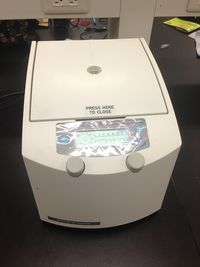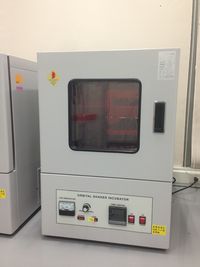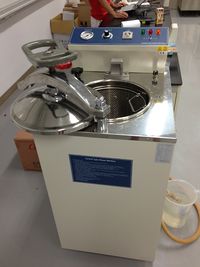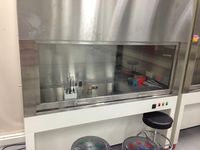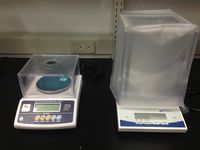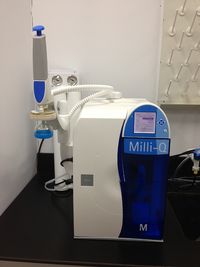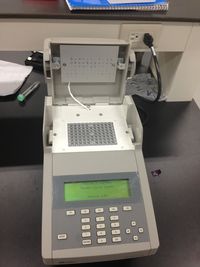Team:NCTU Formosa/Safty
From 2014.igem.org
Contents |
Researcher Safety
1.Everyone must wear lab coat, trousers, gloves, surgery masks and shoes when carrying out experiments.
2.Before the commencement of our project,our team instructors and advisers have guided us to go through every expiriment to make sure everybody is well trained and fit for this project.
3.Everybody has to sterilize his/her hands and all the equipment platforms with alcohol solution(70%) before and after each expiriment.
4.Emergency equipments are well prepared and all the researchers understand how to use these equipments and their exact position.
5.It is not allowed that researcher carries experiment alone.There must be at least two members to conduct the experiment.
6.Food and beverages are not allowed to appear in the lab.
Public safety
1.All collected lab waste are sterilized, packaged and executed.
2.E.coli used in our lab is less competitive than wild type, because they are unable to form biofilms and to thrive in the intestine.
3.Liquid waste that contains E.coli is disinfected by adding peroxides and cleaners before it is disposed.
Instruments in our lab
1.CentrifugeA centrifuge is a piece of equipment, generally driven by an electric motor, that puts an object in rotation around a fixed axis, applying a force perpendicular to the axis. A centrifuge is also used to separate the components in a mixture. The centrifuge works using the sedimentation principle, where the centripetal acceleration causes denser substances to separate out along the radial direction (the bottom of the tube). By the same token lighter objects will tend to move to the top.1 2.incubator
The orbital shaker incubator is widely used in microbiology labs, cell biology labs, etc. It provides a stationary temperature to cultivate bacteria and cells. Some incubator also have functions to maintain the humility level. In our lab, the incubator is maintaining the temperature at 37 degrees Celsius, which is the optical temperature of E.coli growing.
In this year, our team was authorized to work with an non-pathogenic bacterial strain, the Escherichia coli DH5. The strain ais regularly employed in research, industry and study. Biosafety Level 1 standard regulations were strictly followed while using these strains. 3.Autoclave
The autoclave is used for the safety issue. When sterilizing, the pressure and temperature inside reached high level, forming steam and superheat water. Cells will be killed and proteins will be destroyed or denatured. Thus, the safety is ensured.
In our lab, every equipment may contact bacteria will be sterilized before and after use to guarantee the safety.
4.Laminar flow
A laminar flow is an enclosed, ventilated laboratory workspace for safely working with materials contaminated with (or potentially contaminated with) pathogens requiring a defined biosafety level. Several different types of BSC exist, differentiated by the degree of Laminar flow required.5
We strictly rule that all researcher should conduct experiments inside the laminar flow. 5.Balance
An analytical balance is a class of balance designed to measure small mass in the sub-milligram range. The measuring pan of an analytical balance (0.1 mg or better) is inside a transparent enclosure with doors so that dust does not collect and so any air currents in the room do not affect the balance's operation.3
In our lab, we have two models of balance, one is accurate to 0.1 g, another is accurate to 0.1 mg.
6.Water purify system
In this system, Water is purified in a first step using unique Jetpore ion-exchange resin, synthetic activated carbon and UV lamp emitting at 185 and 254 nm to reach a resistivity of 18.2 MΩ.cm at 25 °C and a TOC value below 5 ppb, both monitored by advanced analytical techniques.4
The water purify system is used to produce ultrapure water, which is for experimental use in our lab. 7.Thermal cyclerThe thermal cycler (also known as a thermocycler, PCR machine or DNA amplifier) is a laboratory apparatus most commonly used to amplify segments of DNA via the polymerase chain reaction (PCR). Thermal cyclers may also be used in laboratories to facilitate other temperature-sensitive reactions, including but not limited to restriction enzyme digestion or rapid diagnostics. The device has a thermal block with holes where tubes holding the reaction mixtures can be inserted. The cycler then raises and lowers the temperature of the block in discrete, pre-programmed steps.2
Reference
1.Centrifuge, Wikipedia,http://en.wikipedia.org/wiki/Centrifuge
2.Thermal cycler ,Wikipedia,http://en.wikipedia.org/wiki/Thermal_cycler
3.Analytical balance, Wikipedia,http://en.wikipedia.org/wiki/Analytical_balance
4.Milli-Q Direct, Millipore,http://www.millipore.com/catalogue/module/C85358
5.Laminar flow (Biosafety cabinet), Wikipedia,http://en.wikipedia.org/wiki/Biosafety_cabinet
2014 Safety Form
<a class="gallery slidea" href="#nogo" title="Fishes">
<img src="
pic2.jpg
Photographs courtesy of morgueFile.com</a>
<a class="gallery slideb" href="#nogo" title="Fishes">
<img src="
pic2.jpg
Photographs courtesy of morgueFile.com</a>
<a class="gallery slidec" href="#nogo" title="Fishes">
<img src="
pic2.jpg
Photographs courtesy of morgueFile.com</a>
 "
"
